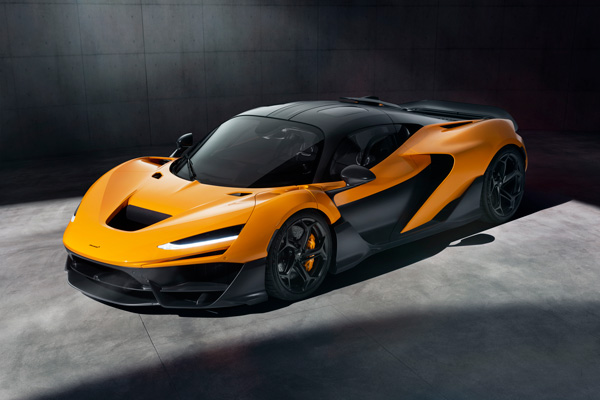
McLaren has revealed the W1, a hybrid-powered road-legal hypercar that the company is calling the successor to two of its most iconic sportscars – the F1 and the P1.
Those were truly epic supercars. The F1, which appeared in 1992, still holds the record of being the fastest naturally aspirated car ever with a top speed of 386km/h. The P1 from 2013, meanwhile, was a hybrid-powered monster which was considered part of the hypercar ‘Holy Trinity’ along with the Ferrari LaFerrari and Porsche 918 Spyder.
Now comes the W1, and in an era when electrification has enabled cars to pump out some outrageous performance figures, there’s no surprise to discover the W1 is right up there with the best of them. The sprint to 100km/h is done in 2.7 seconds, 200km/h is reached in 5.8 seconds, while 300km/h is passed after just 12.7 seconds. Top speed is limited to 350km/h.
All manner of awesome technology goes into making a rear-wheel-drive hypercar deliver these sorts of numbers. Aerodynamics, downforce, weight, tyres and so on are all important, but none are as vital as a truly brutal power source.
McLaren have built the W1 around an epic powertrain – a new hybrid set-up pumping out 938kW thanks to a V8 twin-turbo combustion engine developing 683kW paired with an electric motor, control unit and 1.384kWh battery producing 255kW. There’s an 8-speed transmission with E-reverse, and power and torque are sent to the rear wheels through an E-differential.
Syupporting the powertrain to deliver performance is the W1’s aerodynamics. Leaning on its long experience in developing race cars, McLaren says it has built the W1 with an Aerocell carbon fibre monocoque which is shaped to facilitate full ground effect aerodynamics, producing massive downforce.
When the W1 is put into Race Mode, ride height is lowered – by 37mm at the front and 17mm at the rear – and active front and rear wings are deployed. Along with the underbody ground effect, Race Mode aerodynamics enables the W1 to generate up to 350kg of downforce at the front and 650kg at the rear, giving total downforce of up to 1000kg in high-speed corners.
An Active Long Tail rear wing is, McLaren says, integral to the aerodynamic performance of the car. Actuated by four E-motors and moving up, down, and – depending on whether the W1 is in Road mode or Race mode – 300mm rearwards and adjusting in pitch, the rear wing extends the working area of the rear diffuser in Race Mode and is key to the generation of downforce.
Suspension is as cutting edge as the aerodynamics. It works in combination with the front and rear active aero features allowing the required levels of load and grip to deploy the torque through the driven axle, mitigating the need for all-wheel-drive. The front suspension setup includes titanium torsion bars and an active heave element crosslink, while the rear has a Z-bar with active drop-links to control heave. 3D printing was used for the front uprights and wishbones of the suspension system.
Braking on the W1 sees the McLaren Carbon Ceramic-Racing+ set-up being used, with 390mm discs and 6-piston calipers up front and 4-piston calipers at the rear.
Some very tasty Anhedral Doors open upwards to reveal an interior with a race car feel.
Seating is integrated into the Aerocell monocoque. Both seats are fully upholstered and provide a driving position that is more reclined than usual, with a high level of thigh support.
The pedals, steering wheel and primary controls move, with the right driving position found by adjusting the floor-mounted aluminium pedals. The only two buttons on the steering wheel are Boost and McLaren Aero Deployment controls.
Chassis and powertrain modes are adjusted via rocker controls on the instrument binnacle. The W1’s driver display has been engineered to ensure the full screen remains visible to the driver despite a smaller steering wheel. There’s overhead start/stop, gear selection and Race mode switchgear together with the window controls. These are housed by the digital rear-view display.
Further information and adjustments can be found on the 8-inch touchscreen located between the driver and passenger. This has Apple CarPlay with USB C connectivity, with USB A also provided for device charging and storage access.
Between the fixed seats there is a storage area with a sliding cupholder, while there is a second area for small items behind the armrest. The W1 also has a luggage stowage shelf behind the seats, accessible by moving the headrests, which fold flat forwards to provide a loading platform.
The McLaren W1 is pretty special and comes at a price – around £2 million ($3.86 million) including taxes in the UK, with the final cost dependent on the level of personalisation each owner decides upon.
Just 399 customer cars will be produced.
Source: Motor Trader e-Magazine (October 2024)
30 October 2024
